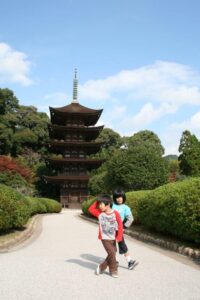junsai ジュンサイ
もう4年も前のことになりますが、嵯峨野のあるレストランでお吸い物(だったと思います)の具として「ジュンサイ」が出て来ました。
スペイン報道関係者の招聘旅行中だったのですが、この昼食はAGT様からのご招待ということで同社より関係者も同席なさっていました。
「これはジュンサイだけど、スペイン語で何というのですか?」という質問があったことを覚えています。突然のことで咄嗟にどんな回答をしたか覚えていないのですが、それ以来ずっと気になっていました。
先日、図書館で借りたペーパーバックに英語の説明がありましたので、備忘のために記録させていただきます。
junsai じゆんさい 草菜 water shield Brasenia schreberi, A little water plant growing in ponds and marshes that has long, thread-like stems thrown up from the root. In spring and early summer these produce leafy shoots enclosed in a gelatinous sheath, which float on the surface and are gathered from small boats. It is an expensive delicacy with virtually no flavor, appreciated for its gelatinous texture. Often served in suimono, it is almost impossible to retrieve with chopsticks. It is also prepared as aemono and is eaten with soy sauce and wasabi, and also with sanbaizu. It is sold loose (in plastic bags) and in bottles.
- Richard Hosking “A Dictionary of Japanese Food” (Tuttle, Feb. 28, 2015)
フォーマルな昼食会だったものですから、残念ながら料理の撮影はできませんでした。どんな料理だったか、今となっては全く記憶にないのです。上記の情報さえあれば、スペイン語でジュンサイの説明も難しくはありませんね。
ところで、このペーパーバックには付録ページがあります。この中にフォーマルな食事についての記述が含まれているのですが、日本料理の特徴が簡潔に表現されていますので、ご紹介させていただきます。同時に、上のツアー中に宿泊した旅館での夕食と朝食の写真を併せて掲載させていただきます。
Formal meals offer the area above all for intricate rules governing appearance, since it is here that appearance is the most important thing. Ka’ichi Tsuji, one of the great master of high-class Japanese cuisine writes, “There is nothing more important in Japanese food than arranging it well, with special regard to the color, on plates chosen to suit the food” (辻嘉一 『四季の盛りつけ料理の色と形』). The absence of any reference to flavor is revealing. Donald Richie, in his highly recommended book A Taste of Japan, writes, “The food is to be looked at as well as eaten. The admiration to be elicited is more, or other, than gustatory. The appeal has its own satisfactions, and it may truly be said in Japan the eyes are at least as large as the stomachs. Certainly the number of rules involving modes and methods of presentation indicate the importance of eye appeal.”
(ibid.:194-5)
【関連記事】
STEP BY STEP 英語表現 253 Your eyes are bigger than your stomach.
また蓴菜(じゅんさい)の大群落もみられる。吸物などに入れて、ぬらりとした口あたりのふしぎさを味わうだけの、やや滑稽を感ずる食べものだが、大阪あたりでは、あっちで甲論に調子をあわせ、こっちで乙論に手をたたいてうなずく人のことを”ジュンサイなやつ“としてきた。
『街道をゆく 34 大徳寺散歩 中津・宇佐のみち』(朝日新聞社 1990年4月10日第一刷発行 216-7頁)
やはりこれも、蓴菜という中国語(室町時代ぐらいにいわれはじめたのだろう)でいうよりも、薦神社にあっては、古語の“ぬなわ”(沼縄。あるい滑[ぬる]の葉からきた?)でよぶと気分がでる。『拾遺集』をしらべてみると、一〇五八に「年毎に春はくれども池水に生ふるぬはなは絶えずぞありける」という歌があり、”絶えずぞあり“というのは、多年生であることをあらわす。
この水草もスイレン科らしい。
ほかに、夏になるとあざやかな黄の花を咲かせる河骨(こうほね)の群落があり、これもスイレン科だそうだから、この池は、睡蓮のいとこ・はとこを従えて大いににぎわっているようである。



